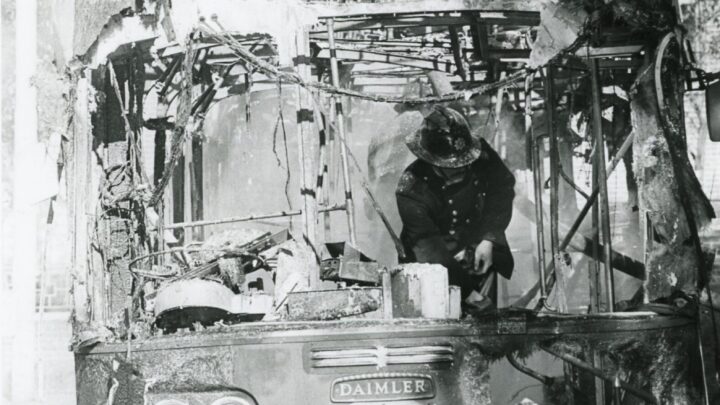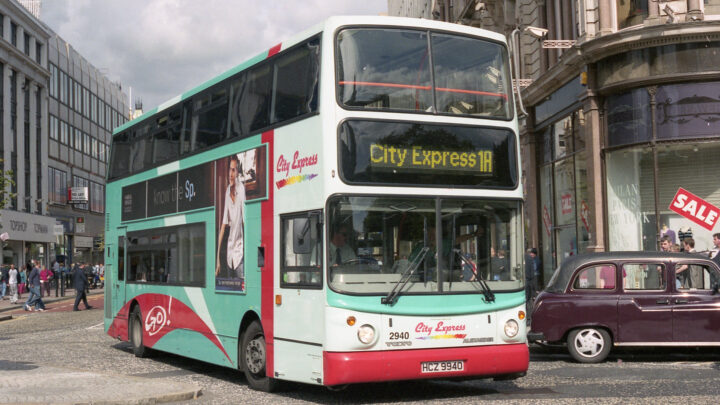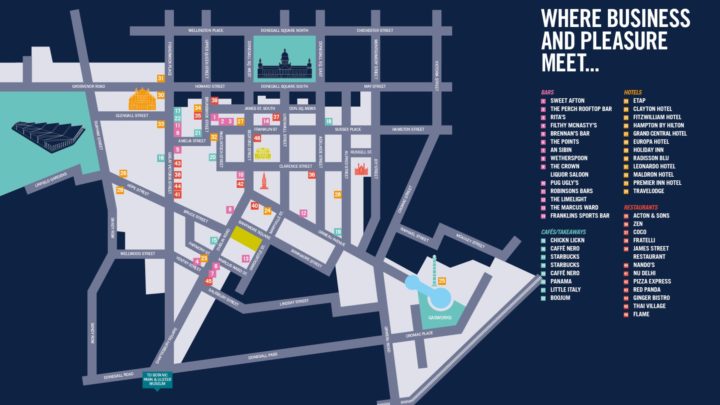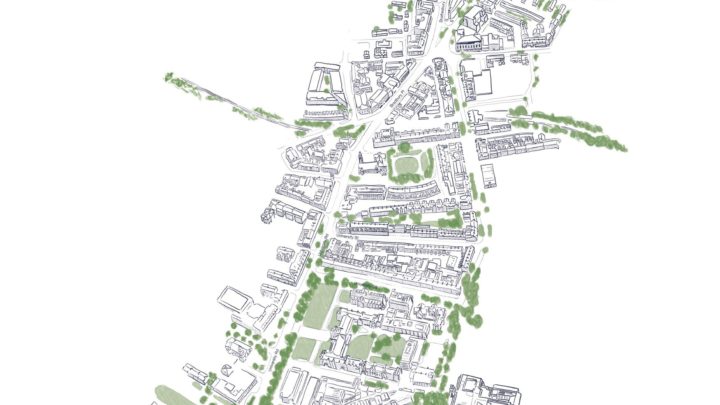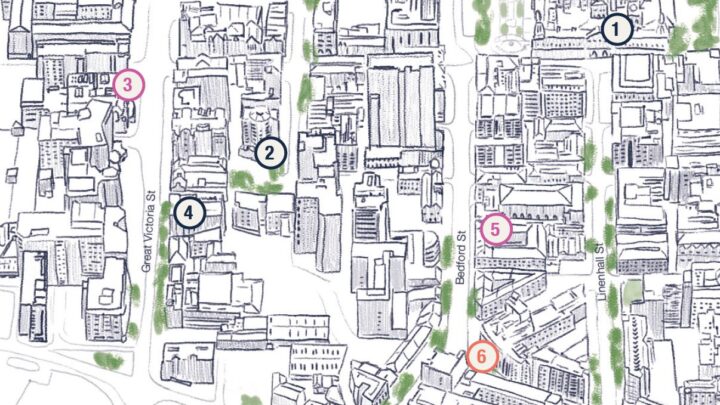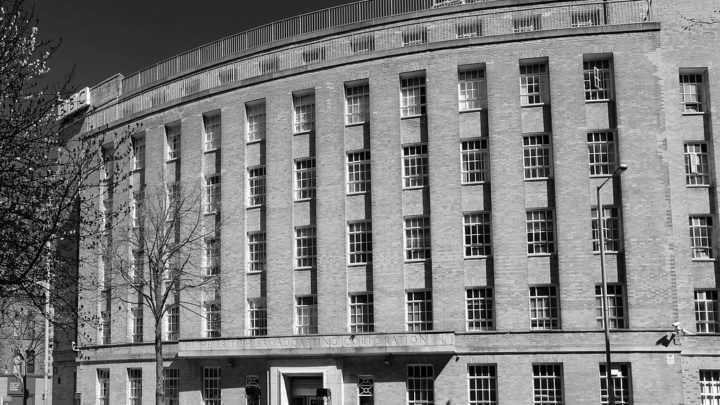History of Belfast public transport
The Story of Belfast Transport
During Summer 2025, the Linen Quarter BID carefully restored a Edwardian-era tram section pillar located on the corner of Linenhall Street and Ormeau Avenue. Its 'discovery' and subsequent media coverage has sparked interest in the history of the wider tram network. The BID therefore commissioned historian Mike Maybin to delve into the story of Belfast Transport...
View the project to restore the tram section pillar.
The first horse tramway opened in Belfast on 28 August 1872 and ran from Castle Place to Botanic Gardens. Initially the Belfast Street Tramways Company which owned the line had only 3 single deck trams, but by February 1973 the line was extended to the Northern Counties Railway Station on York Road via Corporation Street and Great George’s Street. The trams were a great improvement on the horse buses which had preceded them, both in terms of comfort and price, trams being much cheaper.
The new service was moderately successful and the next few years brought extensions to the Courthouse on the Crumlin Road, Richmond on the Antrim Road, Ormeau Bridge on the Ormeau Road, with further development planned for the Lisburn Road and Albertbridge Road to Connswater.
However, the financial returns were less impressive than the London based parent company would have wished and they replaced the manager, W S Totten in November 1881 by Andrew Nance, a young Portsmouth civil engineer. Nance immediately re-organised the route and fare systems and within a short time had significantly increased the Company’s profitability.
As the number of passengers rose the single deck horse cars were replaced by double deck vehicles and the route mileage increased too. The Company’s tenure expired in 1892 and there was considerable public demand that a rental be paid for the “exclusive use of the lines and road way”. The company had an obligation to maintain the road surface between the tracks and for two feet on either side. The rental was set at £5000 for the first seven years of the fourteen years of the renewed contract and £7000 per year for the final seven and this took the Company to 1906.
Historical film footage: Mitchell and Kenyon – A Tram Ride Through Belfast
However, the final quarter of the nineteenth century saw considerable advances in electric traction and from about 1896 pressure began to be exerted on the BST to convert the system to electric traction. The Company was keen to do so but demanded a long lease in which to recoup their expenses while the Belfast Corporation was keen to have electric trams as soon as possible. Eventually the matter was resolved by the Belfast Corporation purchasing the BST in its entirety on 1 January 1905 and converting the system to electric traction. The date of conversion was quite late relative to other municipal tramways; 167 out of 180 municipal systems were electrified before 1906. However once the decision was taken, the whole system was open by 5 December 1905 – almost a British record!
At the time of electrification, the opportunity was taken to extend the system to Greencastle, Cregagh, Stormont, Lisburn Road, Falls Road, Woodvale Road and Duncairn Gardens. The new system proved very popular, faster, more comfortable cheaper than the old horse cars with a maximum fare of 2 old pence. Passenger numbers continued to grow and in 1919 the then General Manager, J S D Moffett increased the fleet by ordering 50 new trams from Brush. They were larger and totally enclosed and lasted almost to the end of tramcar operation. An interesting sidelight is that the next two General Managers, William Chamberlain and Robert McCreary each ordered 50 new trams in 1928 and 1935. Each batch and took the name of the General Manager!
The ten years after the First World War saw relative stability and modest growth in the Undertaking, and on 26 October 1926 the Belfast Corporation “put its toe in the water” and opened an experimental bus service from City Hall to Cavehill Road via Millfield. However, on 1 June 1928 a blow was delivered to the BCT. The Government at Stormont had transferred the licensing of Public Service vehicles from local authorities to the Ministry of Home Affairs, the result of which allowed private (or as the Corporation preferred “pirate”) bus services in competition with the trams. The competition was fierce, unpredictable and dangerous and incurred a significant drop in Transport Department revenue. The “Bus War”, as it was known, raged for 5 months with bus routes opening and closing apparently at random. On the “pro-bus” side the new vehicles were cheaper and often quicker and more comfortable than the trams with whom they sought to compete. If you lived on the Dundonald or Glengormley routes you were spoilt for choice, but if you resided on one of the less profitable areas e.g. Ravenhill or Ballygomartin you were much less fortunate!
Clearly matters could not continue in this way and the government launched a public enquiry. It reported that agreement had been reached between the private operators and the BCT in which
- The BCT would have a monopoly within the City Boundary and a quarter of a mile beyond, but could be varied by written permission from the Corporation.
- Private operators would not be allowed to pick up and set down within this area
- The BCT would buy 50 buses from the private operators
- The Corporation would take over a number of the private operators’ routes.
The General Manager Samuel Carlisle was blamed for the débâcle and he was demoted to Deputy.
The 1930’s provided a relatively stable period for the Transport Department. His replacement, William Chamberlain was “head-hunted” from Leeds and took up post in 1929. He immediately ordered 50 new upholstered, fully enclosed and heated cars from Brush and they took his name! In addition, he arranged for 50 of the original Standard Reds to be rebuilt to a similar standard, and the fleet to be repainted blue! That meant the fleet included 150 totally enclosed cars which was adequate to operate the “off peak” service.
However, Chamberlain stayed only 2 years and was replaced in August 1931 by Robert McCreary, who held a first-class civil engineering degree and had worked his way up the department to the post of permanent way engineer by 1919. In 1935 he followed the tradition of ordering 50 new trams of a modern streamlined nature and they took his name too! McCreary was an enthusiastic advocate of electric transport vehicles.
Historical film footage: Belfast Harbour Scenes. Leaving work
In 1930 Belfast Corporation obtained powers to operate trolleybuses within the City Boundary. During the 1930’s many British cites began to operate trolleybuses to replace trams but Belfast’s first trolleybus service began on the Falls Road in 1938, once again being one of the last cities in Britain to operate trolleybuses. (45th out of 50). Ever cautious the Transport Committee bought 14 trial vehicles from seven manufacturers, six suppliers of electric equipment and five bodybuilders, in order to evaluate the best combination for Belfast. When the decision was taken in 1939 to go for tram abandonment, 112 new trolleybuses were ordered with Associated Equipment Company (AEC) chassis, British Thompson Houston (BTH) electrical equipment and the Belfast firm of Harknes supplying the bodies. However, the declaration of war on 3rd September 1939 saw the order summarily reduced to 88 vehicles. Major McCreary reported for active duty the day before. He didn’t return till 1945 and was replaced by Samuel Carlisle as Acting General Manager for the duration.
As with all public transport three main effects took place in Belfast. The first was the huge increase in passenger numbers from 134 million in 1938 to 257 million in 1945; secondly lack of resources reduced maintenance to an absolute minimum and thirdly, although Northern Ireland didn’t have conscription, many men, including drivers and conductors, volunteered. Throughout the war trams gradually gave way to trolleybuses in East Belfast, but the displaced trams were immediately used to strengthen services elsewhere. The majority of the 1905 Standard Reds were still in service forty years later!
Historical film footage: Super 8 Stories (Belfast Trolleybuses)
Col McCreary (as he had become) retired in 1951 and was replaced by Joseph Mackle who had been Chief Engineer with HMS Catherwood, Road Motor Superintendent with the Great Northern Railway bus division and joined the Belfast Transport Department. as head of the coach building and motor bus sections. In 1939 he became Acting Deputy General Manager and General Manager in 1951. He was a motorbus man through and through and quickly slowed down the trolleybus replacement of the trams and substituted motor buses instead. He was General Manager in 1958 when the Committee decided to abandon the trolleybuses in favour of motorbuses. He retired in April 1963 and was succeeded by Robin Adams. As with Col McCreary, Robin Adams graduated with a first-class degree in Electrical Engineering. Although a strong supporter of electric traction by the time Adams was promoted to the top job, the decision to abandon trolleybuses had been taken five years previously and in fact was completed in 1968.
Adams final five years were marked by major civil unrest in Belfast and elsewhere in Northern Ireland during which hundreds of buses were destroyed, resulting in withdrawal of service, detours to avoid bombs and frequent robbing the drivers’ takings.
The major political changes imposed after the suspension of the Northern Ireland Parliament saw the Belfast Corporation relieved of its transport responsibilities which were transferred to the Northern Ireland Transport Holding company (effectively Ulsterbus) in April 1973. The new organisation for city buses was, appropriately, called Citybus, which was maintained as a separate entity for many years despite sharing a common management with Ulsterbus. Citybus inherited a fleet of largely double deckers which was gradually replaced with standee single deckers mostly with 32 plastic seats! While this reflected Managing Director Werner Heubeck’s preference, it also took into account the major destruction of buses during this period (over 1400 in total).
In order to keep services running during this difficult period Citybus and Ulsterbus purchased large numbers of second-hand vehicles from over 20 mainland operators.
The signing of the Belfast Agreement in April 1998 saw the rate of destruction reduced dramatically; new comfortable buses were bought; services were extended and strengthened and passenger numbers increased.
Citybus was incorporated into the Translink company in April 1996 and rebranded as “Metro” in February 2005. The fleet colour was altered to pink and white. Since 2022, Translink has been gradually replacing petrol buses with a modern fleet of Electric and Hydrogen buses, with a view to operate a net zero fleet by 2040.
The Glider service was introduced in September 2018 as a “bus rapid transit” system between McKinstry Road in West Belfast and Dundonald Park and Ride in East Belfast via the City Centre. A second route operates between the City Hall and Titanic Quarter on Queen’s Road. There are plans in place to extend the Glider network along the Antrim Road in the North and Ormeau Road in the Southeast and along a Southwestern loop leading past City Hospital and Queen’s University.
Content provided by Mike Maybin
![The very early horse cars were single deck, usually pulled by one horse. No 19 is in York Street near tot the junction with Donegall Street and bound for the Northern Counties Railway Station. The cross over to the opposite track is just visible as is the horse at the front of the car. The conductor is just releasing the handbrake. The date is probably the late 1870s. [Credit: National Library of Ireland]](https://linenquarter.org/app/uploads/2025/09/LQ1-720x405.jpg)
![Horse tram 29 in Victoria Street passing the Petty Sessions Court, which until the City Hall was opened in 1906 served as the official Town Hall. On the left is Victoria Square and the Jaffe fountain, which was moved to Botanic Gardens in the 1930s but returned to its present location in 2008. [Credit: National Library of Ireland]](https://linenquarter.org/app/uploads/2025/09/LQ2-720x405.jpg)
![A busy scene at Castle Junction, probably in the late 1880s showing 4 double deck horse trams and a horse bus. Note the taller gas lamp in the middle of the junction before the widened tracks had been laid in Castle Place. [credit: National Library of Ireland]](https://linenquarter.org/app/uploads/2025/09/LQ3-720x405.jpg)
![A mixture of double deck and single deck trams in High Street. No 7 is headed to Richmond or Fortwilliam Park. In those days Richmond Park was on the Antrim Road near to its junction with Cavehill Road. Note the spindly iron steps to the upper deck and the sunshade shielding the side windows [credit: National Library of Ireland]](https://linenquarter.org/app/uploads/2025/09/LQ4-720x405.jpg)
![Horse tram No 27 about to turn right from Donegall Place to Donegall Square North en route to Botanic Gardens. The picture was taken before 1890 as the fourth bay has yet to be added to Robinson and Cleaver's department store. The Store relocated here in 1887 from Castle Place. The store closed in 1984 and the building converted to individual shops and offices. [credit: National Library of Ireland]](https://linenquarter.org/app/uploads/2025/09/LQ5-720x405.jpg)
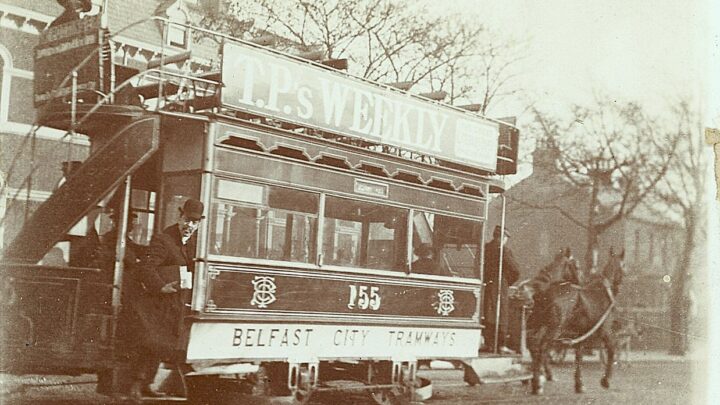
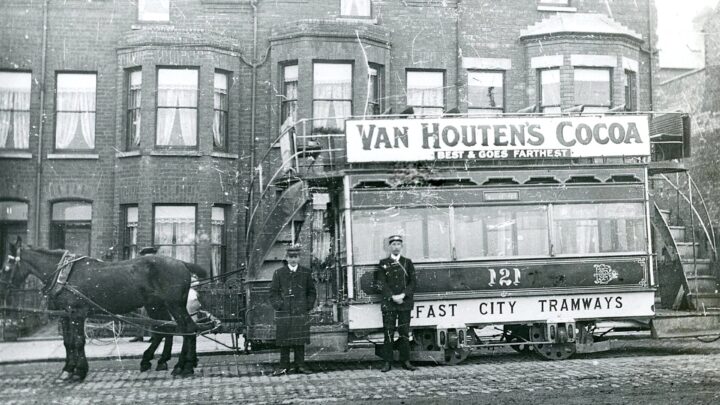
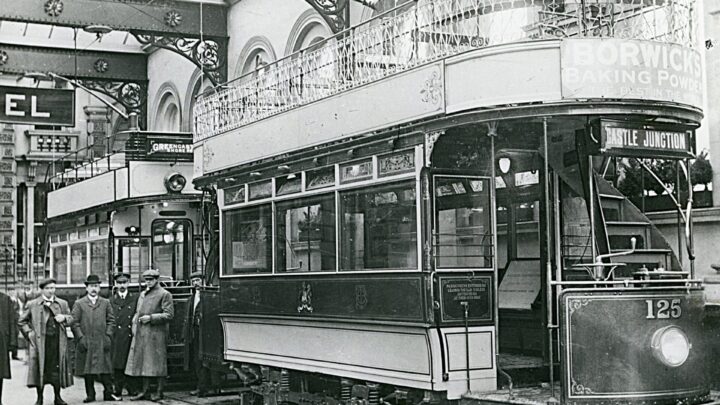
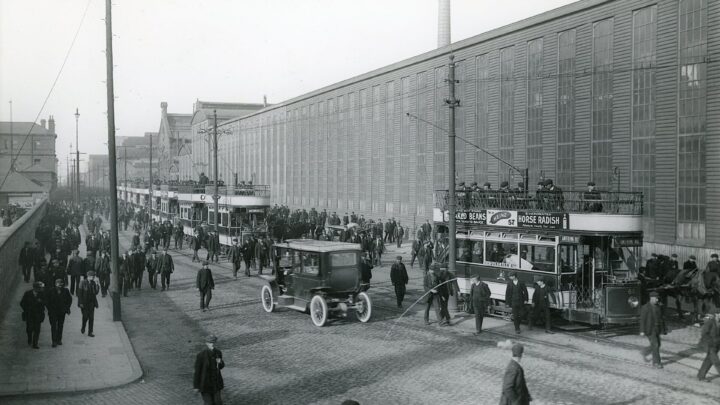
![Standard Red 74, now fitted with a top cover poses for one of a series of images to demonstrate safety procedures near the Falls Road terminus. This scene would be totally unrecognizable today! [credit: C. Wilson / Belfast Corporation Transport]](https://linenquarter.org/app/uploads/2025/09/LQ10-720x405.jpg)
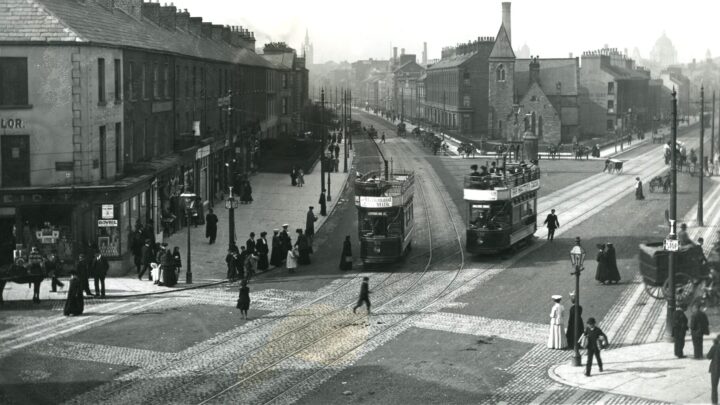
![When the Cavehill and Whitewell Tramway was taken over by the BCT in 1911, eight trams were taken over and became 193 - 200 in the Belfast fleet. They were converted to look like Standard Reds.This is 199 taken at Ardoyne depot in 1938. [credit: W.A. Camwell]](https://linenquarter.org/app/uploads/2025/09/LQ12-720x405.jpg)
![In 1920 the then General Manager Moffett ordered 50 new enclosed cars which took his name, 314, 319, and 320 were photographed in High Street in the early 1920s. Note the route number blinds carried black numerals on a white background - reversed shortly afterwards. The track leading into Bridge Street can just be seen behind No 320. Before the Second World War, Bridge Street was very narrow - until the German Luftwaffe helped convert it to a dual carriageway! [credit: W. Camwell]](https://linenquarter.org/app/uploads/2025/09/LQ13-720x405.jpg)
![Moffett 328 and an identified McCreary taken at Ardoyne in the late 1940s. The overhead wires in the centre of the picture are leading to Ardoyne depot. The bus stop on the right belongs to the Northern Ireland Road Transport Board (NIRTB) which was succeeded by the Ulster Transport Authority (UTA) in 1948. [credit: J.H. Price]](https://linenquarter.org/app/uploads/2025/09/LQ14-720x405.jpg)
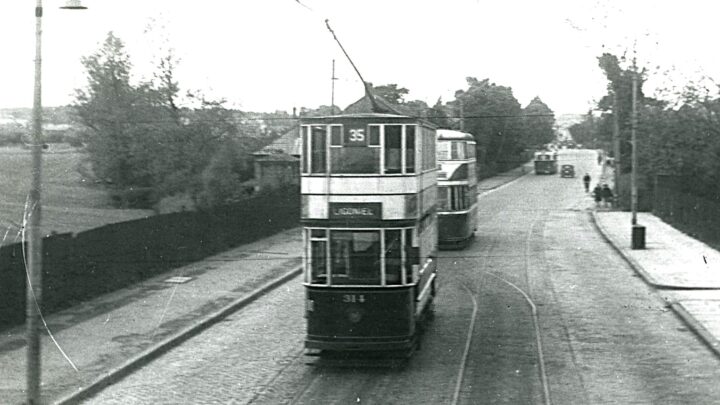
![Chamberlain 342 is posed outside the Brush works in Loughborough in 1930. A large body of opinion considers the Chamberlains one of the finest tramcars made. When new they were liberally supplied with destination information, having destination boxes at either end, top deck route number boxes front and back, lower deck route number boxes in each driving cab, roller blind combined destination and route number blinds on either side and provision for route boards at the bottom of the centre side windows. [credit: Brush Co.]](https://linenquarter.org/app/uploads/2025/09/LQ16-720x405.jpg)
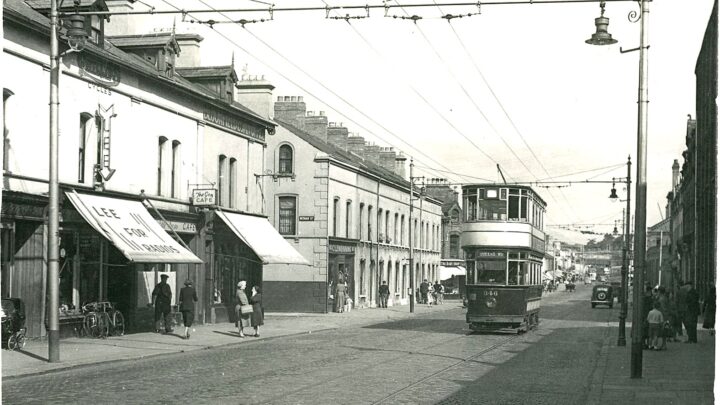
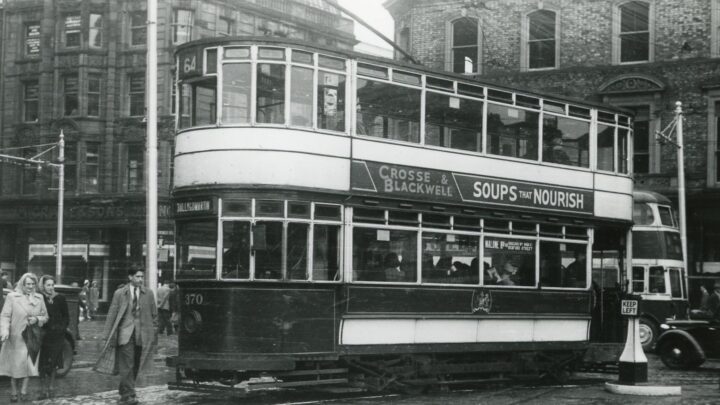
![For a few months in 1953-4 Ligoniel trams reversed in Wellington Place over a newly constructed cross-over. This was considered to be safer for passengers than the busier Donegall Square North. The trolley has been swung and is on the other side of the road. [credit: Roy Brook]](https://linenquarter.org/app/uploads/2025/09/LQ19-720x405.jpg)
![In 1935 the then General Manager Robert McCreary ordered 50 new cars from the English Electric Company of Preston which carried the fleet numbers 392 to 441. No 395 is seen in Albertbridge Road in 1952 on its way to Mountpottinger depot. By this date most of East Belfast had been converted to trolleybus operation and tramcar operation was reduced to peak hour depot workings.In this case the McCreary and the Chamberlain behind it were using the positive wire of the trolleybus overhead, [credit: Roy Brook]](https://linenquarter.org/app/uploads/2025/09/LQ20-720x405.jpg)
![McCreary 101 and Rebuild 164 were photographed at the Springfield terminus in August 1952. Springfield and Crumlin Road termini were linked via the city centre although they were only a short distance apart as the crow flies. [credit: Roy Brook]](https://linenquarter.org/app/uploads/2025/09/LQ21-720x405.jpg)
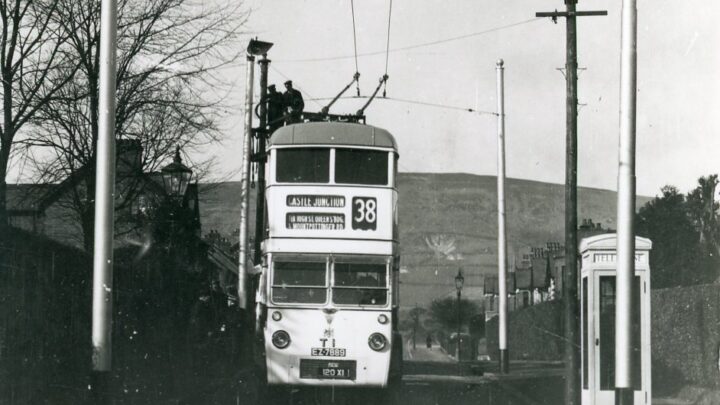
![T2 taken at around the same time, with Falls depot just visible in the background. Both T1 and T2 were AECs with English Electric equipment and Harkness 68 seat bodywork. [credit: Clough Smith]](https://linenquarter.org/app/uploads/2025/09/LQ23-720x405.jpg)
![The Whitehouse route had two intermediate termini for short workings, one at Grove Park at the junction of Shore Road and North Queen Street where this shot was taken in 1963 with the Grove swimming baths in the background. [credit: Richard Whitford]](https://linenquarter.org/app/uploads/2025/09/LQ24-720x405.jpg)
![When the Dundonald route was opened in 1942 the trolleybus terminus was at the Elk Inn located at the junction of the Upper Newtownards and Comber Roads. The terminus was anti clockwise and very tight. Guy 143 is heading back to the city centre. The date of the photograph is April 1962, and the scene is unrecognisable today. [credit: Richard Whitford]](https://linenquarter.org/app/uploads/2025/09/LQ25-720x405.jpg)
![AECs 32 and 29 near Castlereagh terminus in the early 1940s. For a while trolleybuses turned in the mouth of the Castlereagh Road / Knock Road / Ballygowan Road. This quiet rural cross roads is a major four lane junction now. [credit: W.J. Wyse]](https://linenquarter.org/app/uploads/2025/09/LQ26-720x405.jpg)
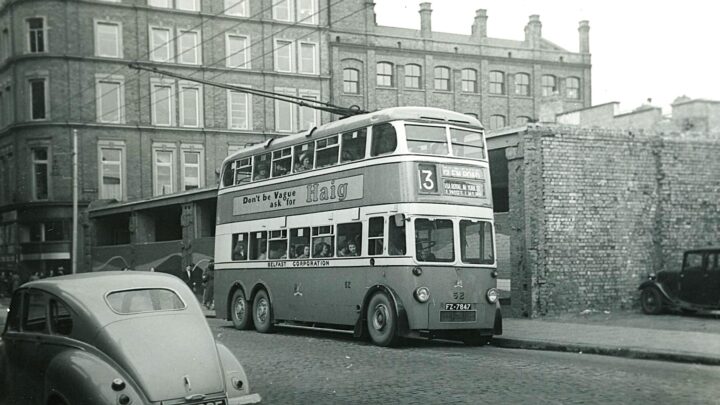
![In 1958 the Falls Road terminus was extended from Fruithill Park to Casement Park and 246 has just left the stop. The land on which the turning circle sits was rented from the Gaelic Athletic Association. The turning circle was very tight with the overhead consisting of curved segments which gave a smoother passage for the trolley heads than span wire construction. [credit: Richard Whitford]](https://linenquarter.org/app/uploads/2025/09/LQ28-720x405.jpg)
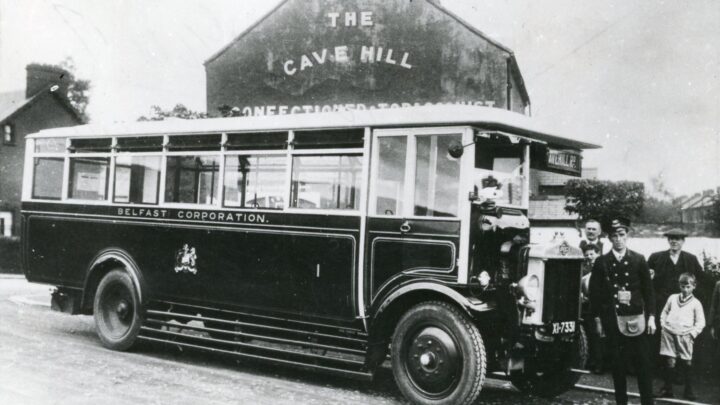
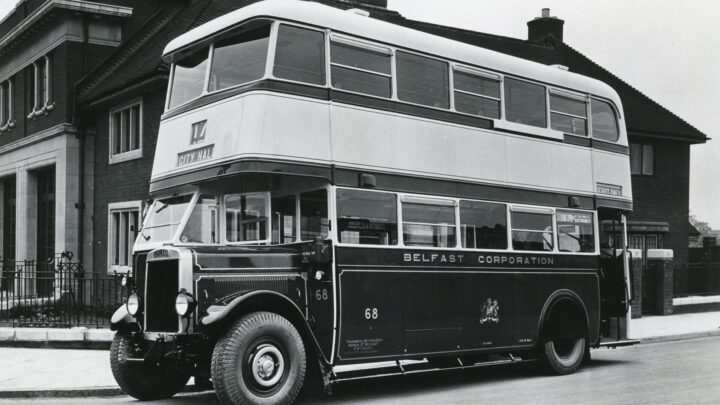
![In 1935 the Transport Department acquired 20 Dennis Lancet single deckers with 31 seat bodies by Service Motor Works. She was rebodied and re-engined in 1949, subsequently used as a training bus, and has been preserved and in storage. She is seen here at an Irish Transport Trust rally at Ballyholme. [credit: R. Ludgate collection]](https://linenquarter.org/app/uploads/2025/09/LQ31-720x405.jpg)
![One of the very few full fronted motorbuses purchased by Belfast. 129 was a 1937 AEC Regent with 52 seat Cowieson bodywork. It is posed when new in front of Parliament Buildings, which provides a very impressive background. [credit: Brian Boyle collection]](https://linenquarter.org/app/uploads/2025/09/LQ32-720x405.jpg)
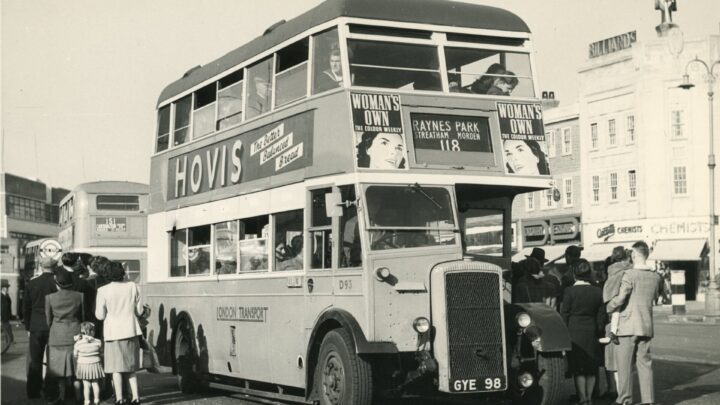
![The same vehicle taken with its new Harkness (1954) body. She is preserved and has taken part in a number of rallies organised by the Irish Transport Trust. This photograph was taken in 1975. This bodywork pattern was applied to hundreds of Belfast buses and became the de facto standard. [credit: Ken Seawright]](https://linenquarter.org/app/uploads/2025/09/LQ034-720x405.jpg)
![When it was decided to abandon the trolleybus network in 1958 the Corporation sought a suitable replacement vehicle, and after trialling four demonstrators chose the Daimler CRG6 with MH Coachworks 77 seat body. 687 shown here entered service in 1964 and passed to Citybus in 1973, renumbered 2687 and was withdrawn in 1976 following malicious damage. [credit: Richard Whitford]](https://linenquarter.org/app/uploads/2025/09/LQ035-720x405.jpg)
![Following Citybus's takeover of the BCT undertaking in 1973 the standard bus was the Bristol RELL and many hundreds of the type were bought from 1975 onwards. 2415 was new in 1980 and withdrawn from service in 1995. She had 32 hard plastic seat Alexander bodywork with places for 21 standees - a figure often exceeded during rush hour! [credit: Raymond Bell]](https://linenquarter.org/app/uploads/2025/09/LQ036-720x405.jpg)
